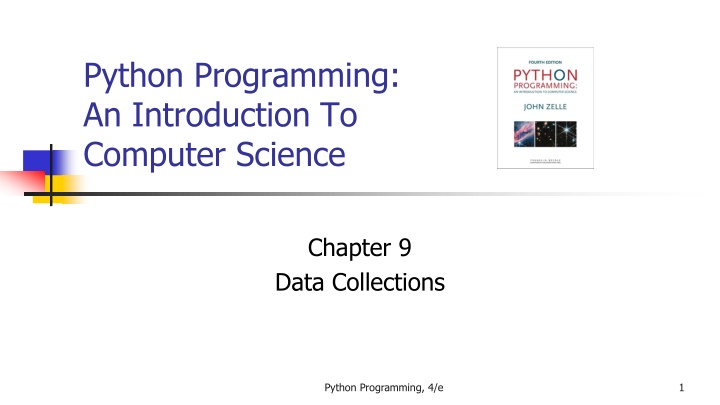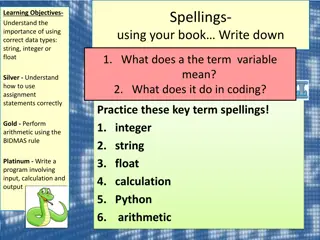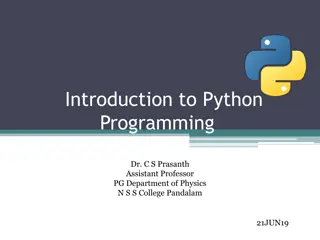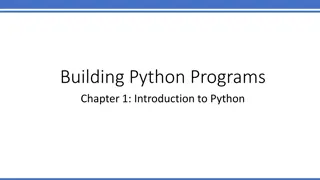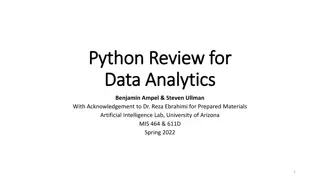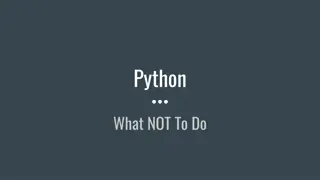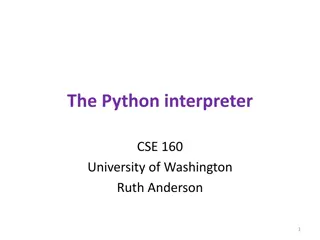Introduction to Data Collections in Python Programming
In this introduction to computer science chapter, you will explore the use of lists, tuples, and dictionaries in Python to represent and manipulate collections of data. Learn about the functions and methods available for working with Python lists and understand how to group related values using tuples. Explore Python dictionaries as a data structure for storing non-sequential collections of information. Dive into examples related to simple statistics and learn how to extend programs to compute mean, median, and standard deviation.
Download Presentation

Please find below an Image/Link to download the presentation.
The content on the website is provided AS IS for your information and personal use only. It may not be sold, licensed, or shared on other websites without obtaining consent from the author.If you encounter any issues during the download, it is possible that the publisher has removed the file from their server.
You are allowed to download the files provided on this website for personal or commercial use, subject to the condition that they are used lawfully. All files are the property of their respective owners.
The content on the website is provided AS IS for your information and personal use only. It may not be sold, licensed, or shared on other websites without obtaining consent from the author.
E N D
Presentation Transcript
Python Programming: An Introduction To Computer Science Chapter 9 Data Collections Python Programming, 4/e 1
Objectives To understand the use of lists (arrays) to represent a sequential collection of data. To be familiar with the functions and methods available for manipulating Python lists. To understand the use of tuples for grouping a set of related values. To be familiar with Python dictionaries as a data structure for storing non-sequential collections. Python Programming, 4/e 2
Objectives To be able to write programs that use lists and tuples to structure and manipulate collections of information. Python Programming, 4/e 3
Example Problem: Simple Statistics Many programs deal with large collections of similar information. Words in a document Students in a course Data from an experiment Customers of a business Graphics objects drawn on the screen Cards in a deck Python Programming, 4/e 4
Example Problem: Simple Statistics Let s review some code we wrote in chapter 7: # average4.py # A program to average a set of numbers # Illustrates sentinel loop using empty string as sentinel def main(): sum = 0.0 count = 0 xStr = input("Enter a number (<Enter> to quit) >> ") while xStr != "": x = float(xStr) sum = sum + x count = count + 1 xStr = input("Enter a number (<Enter> to quit) >> ") print("\nThe average of the numbers is", sum / count) Python Programming, 4/e 5
Example Problem: Simple Statistics This program allows the user to enter a sequence of numbers, but the program itself doesn t keep track of the numbers that were entered it only keeps a running total. Suppose we want to extend the program to compute not only the mean, but also the median and standard deviation. Python Programming, 4/e 6
Example Problem: Simple Statistics The median is the data value that splits the data into equal-sized parts. For the data [2, 4, 6, 9, 13], the median is 6, since there are two values greater than 6 and two values that are smaller. One way to determine the median is to store all the numbers, sort them, and identify the middle value. Python Programming, 4/e 7
Example Problem: Simple Statistics The standard deviation is a measure of how spread out the data is relative to the mean. If the data is tightly clustered around the mean, then the standard deviation is small. If the data is more spread out, the standard deviation is larger. The standard deviation is a yardstick to measure/express how exceptional a value is. Python Programming, 4/e 8
Example Problem: Simple Statistics The standard deviation is 2 ? ?? ? 1 ? = Here is the mean, represents the ith data value and n is the number of data values. The expression is the square of the deviation of an individual item from the mean. ?? ? 2 ? ?? Python Programming, 4/e 9
Example Problem: Simple Statistics The numerator is the sum of these squared deviations across all the data. Suppose our data was [2, 4, 6, 9, 13]. The mean ( ?) is 6.8 The numerator of the standard deviation is 6.8 22+ 6.8 42+ 6.8 62+ 6.8 92+ 6.8 132= 74.8 74.8 5 1= ? = 18.7 = 4.32 Python Programming, 4/e 10
Example Problem: Simple Statistics As you can see, calculating the standard deviation not only requires the mean (which can t be calculated until all the data is entered), but also each individual data element! We need some way to remember these values as they are entered Python Programming, 4/e 11
Python Lists We need a way to store and manipulate an entire collection of numbers. We can t just use a bunch of variables, because we don t know many numbers there will be. What do we need? Some way of combining an entire collection of values into one object. We ve already done something like this before Python Programming, 4/e 12
Python Lists >>> list(range(10)) [0, 1, 2, 3, 4, 5, 6, 7, 8, 9] >>> "This is an ex-parrot!".split() ['This', 'is', 'an', 'ex-parrot! ] Both of these familiar functions return a collection of values denoted by the enclosing square brackets. Lists are the most common way of handling collections of data in a Python program. Python Programming, 4/e 13
Lists and Arrays as Sequences Python lists are ordered sequences of items. For instance, a sequence of n numbers might be called S: S = s0, s1, s2, s3, , sn-1 Specific values in the sequence can be referenced using subscripts, e.g. the first item is denoted with the subscript 0 (s0 ) By using numbers as subscripts, mathematicians can succinctly summarize computations over items in a sequence using subscript variables. ? 1 ?? ?=0 Python Programming, 4/e 14
Lists and Arrays as Sequences Suppose the sequence is stored in a variable s. We could write a loop to calculate the sum of the items in the sequence like this: sum = 0 for i in range(n): sum = sum + s[i] Almost all computer languages have a sequence structure like this, sometimes called an array. Python Programming, 4/e 15
Lists and Arrays as Sequences A list or array is a sequence of items where the entire sequence is referred to by a single name (i.e. s) and individual items can be selected by indexing (i.e. s[i]). In other programming languages, arrays are generally a fixed size, meaning that when you create the array, you have to specify how many items it can hold. Arrays are generally also homogeneous, meaning they can hold only one data type. Python Programming, 4/e 16
Lists and Arrays as Sequences Python lists are dynamic. They can grow and shrink on demand. Python lists are also heterogeneous, a single list can hold arbitrary data types. Python lists are mutable sequences of arbitrary objects. Python Programming, 4/e 17
Lists Operations Operator <seq> + <seq> <seq> * <int-expr> Repetition <seq>[] len(<seq>) <seq>[:] for <var> in <seq>: Iteration <expr> in <seq> Meaning Concatenation Indexing Length Slicing Membership (Boolean) Python Programming, 4/e 18
Lists Operations Except for the membership check, we ve used these operations before on strings. The membership operation can be used to see if a certain value appears anywhere in a sequence. >>> lst = [1,2,3,4] >>> 3 in lst True Python Programming, 4/e 19
Lists Operations The summing example from earlier can be written like this: sum = 0 for x in s: sum = sum + x Unlike strings, lists are mutable: >>> lst = [1,2,3,4] >>> lst[3] 4 >>> lst[3] = "Hello >>> lst [1, 2, 3, 'Hello'] >>> lst[2] = 7 >>> lst [1, 2, 7, 'Hello'] Python Programming, 4/e 20
Lists Operations Lists can be created by listing items inside square brackets. odds = [1, 3, 5, 7, 9] food = ["spam", "eggs", "back bacon"] silly = [1, "spam", 4, "U"] empty = [] A list of identical items can be created using the repetition operator. This command produces a list containing 50 zeroes: zeroes = [0] * 50 Python Programming, 4/e 21
Lists Operations # month2.py # A program to print the month abbreviation, given its number. def main(): # months is a list used as a lookup table months = ["Jan", "Feb", "Mar", "Apr", "May", "Jun", "Jul", "Aug", "Sep", "Oct", "Nov", "Dec"] n = int(input("Enter a month number (1-12): ")) print(f"The month abbreviation is {months[n-1]}.") Python Programming, 4/e 22
Lists Operations In this program there is a list of strings called months to use as the lookup table. This line of code is split over two lines Python knows the list isn t finished until the ] is encountered. This makes the code more readable. Lists, like strings, are indexed beginning with 0. months[0] is "Jan". The nth month is at position n-1. Python Programming, 4/e 23
Lists Operations It would be trivial to modify this program to print out the entire month name. Just change the lookup list! months = ["January", "February", "March", "April", "May", "June", "July", "August", "September", "October", "November", "December"] Python Programming, 4/e 24
Lists Methods Method Meaning <list>.append(x) Add element x to end of list. <list>.sort() Sort (order) the list. A comparison function may be passed as a parameter. Reverse the list. <list>.reverse() <list>.index(x) Returns index of first occurrence of x. <list>.insert(i, x) Insert x into list at index i. <list>.count(x) Returns the number of occurrences of x in list. <list>.remove(x) Deletes the first occurrence of x in list. <list>.pop(i) Deletes the ith element of the list and returns its value. Python Programming, 4/e 25
Lists Methods >>> lst = [] >>> lst.append("lists") >>> lst ['lists ] >>> lst.append("are") >>> lst.append("fun") >>> lst ['lists', 'are', 'fun ] >>> lst.sort() >>> lst ['are', 'fun', 'lists'] >>> lst ['lists', 'fun', 'are ] >>> lst.index("fun") 1 >>> lst.insert(0, "fun") >>> lst ['fun', 'lists', 'fun', 'are ] >>> lst.count("fun") 2 >>> lst.remove("fun") >>> lst ['lists', 'fun', 'are'] Python Programming, 4/e 26
Lists Methods Most list methods either modify the list (e.g. append, sort, remove, extend) or leave the list unchanged and return a value (e.g. count and index). However, the pop method actually does both! When you want to remove a specific valued item from a list, remove does the job ,whereas pop removes the item from a given position. Calling pop without a parameter (e.g. lst.pop()) will always remove the last item from the list. Python Programming, 4/e 27
Lists Methods Using append is the most common and efficient way of adding an item to an existing list. It is often used to accumulate a list one item at a time. Python Programming, 4/e 28
Lists Methods Here is a fragment of code using a sentinel loop to build a list of positive numbers typed by the user: nums = [] x = float(input('Enter a number: ')) while x >= 0: nums.append(x) x = float(input('Enter a number: ')) Python Programming, 4/e 29
Lists Methods Basic list principles A list is a sequence of items stored as a single object. Items in a list can be accessed by indexing, and sublists can be accessed by slicing. Lists are mutable; individual items or entire slices can be replaced through assignment statements. Lists support a number of convenient and frequently used methods. Lists will grow and shrink as needed. Python Programming, 4/e 30
Statistics with Lists One way we can solve our statistics problem is to store the data in a list. We could then write a series of functions that take a list of numbers and calculates the mean, standard deviation, and median. Let s rewrite our earlier program to use lists to find the mean. Python Programming, 4/e 31
Statistics with Lists Let s write a function called getNumbers that gets numbers from the user. We ll implement the sentinel loop to get the numbers. An initially empty list is used as an accumulator to collect the numbers. The list is returned once all values have been entered. Python Programming, 4/e 32
Statistics with Lists def getNumbers(): nums = [] # start with an empty list # sentinel loop to get numbers xStr = input("Enter a number (<Enter> to quit) >> ") while xStr != "": x = float(xStr) nums.append(x) # add this value to the list xStr = input("Enter a number (<Enter> to quit) >> ") return nums Using this code, we can get a list of numbers from the user with a single line of code: data = getNumbers() Python Programming, 4/e 33
Statistics with Lists Now we need a function that will calculate the mean of the numbers in a list. Input: a list of numbers Output: the mean of the input list def mean(nums): sum = 0.0 for num in nums: sum = sum + num return sum / len(nums) Python Programming, 4/e 34
Statistics with Lists The next function to tackle is the standard deviation. In order to determine the standard deviation, we need to know the mean. Should we recalculate the mean inside of stdDev? Should the mean be passed as a parameter to stdDev? Recalculating the mean inside of stdDev is inefficient if the data set is large. Since our program is outputting both the mean and the standard deviation, let s compute the mean and pass it to stdDev as a parameter. Python Programming, 4/e 35
Statistics with Lists def stdDev(nums, xbar): sumDevSq = 0.0 for num in nums: dev = xbar - num sumDevSq = sumDevSq + dev * dev return sqrt(sumDevSq/(len(nums)-1)) The summation from the formula is accomplished with a loop and accumulator. sumDevSq stores the running sum of the squares of the deviations. Python Programming, 4/e 36
Statistics with Lists We don t have a formula to calculate the median. We ll need to come up with an algorithm to pick out the middle value. First, we need to arrange the numbers in ascending order. Second, the middle value in the list is the median. If the list has an even length, the median is the average of the middle two values. Python Programming, 4/e 37
Statistics with Lists Pseudocode - sort the numbers into ascending order if the size of the data is odd: median = the middle value else: median = the average of the two middle values return median Python Programming, 4/e 38
Statistics with Lists def median(nums): nums.sort() size = len(nums) midPos = size // 2 if size % 2 == 0: median = (nums[midPos] + nums[midPos-1]) / 2 else: median = nums[midPos] return median Python Programming, 4/e 39
Statistics with Lists With these functions, the main program is pretty simple! def main(): print("This program computes mean, median and standard deviation.") data = getNumbers() xbar = mean(data) std = stdDev(data, xbar) med = median(data) print("\nThe mean is", xbar) print("The standard deviation is", std) print("The median is", med) Python Programming, 4/e 40
Statistics with Lists Statistical analysis routines might come in handy some time, so let s add the capability to use this code as a module by adding: if __name__ == '__main__': main() Python Programming, 4/e 41
Pythonic List Manipulation Python provides list comprehensions as a simple, direct way of creating lists. Suppose instead of using the sentinel loop in getNumbers, we would like to gfet all of the numbers in a single line of input, similar to the decoder program in Chapter 8. Python Programming, 4/e 42
Pythonic List Manipulation The simple approach: inStr = input("Enter numbers below separated by spaces and press <Enter>:\n") nums = [] for numStr in inStr.split(): nums.append(float(numStr)) The Pythonic approach: nums = [float(numStr) for numStr in inStr.split()] Python Programming, 4/e 43
Pythonic List Manipulation nums = [float(numStr) for numStr in inStr.split()] The right hand side creates a list consisting of the items we get by applying the float function to each string in the split of inStr. The general form for list comprehension looks like this: [<expr> for <variable> in <sequence>] Python Programming, 4/e 44
Pythonic List Manipulation [<expr> for <variable> in <sequence>] Semantically, this creates a new list, with items formed by evaluating the expression for each value of the variable as it iterates over the sequence. List comprehensions are handy for building lists out of other sequences and using them produces more concise, readable, and efficient solution than writing the equivalent accumulator loop. Python Programming, 4/e 45
Pythonic List Manipulation Another trick: make use of functions that take a list an an input parameter. E.g. to find the maximum value in a list of numbers: maximum = max(nums) There are also built in functions for minimum (min) and sum. Python Programming, 4/e 46
Pythonic List Manipulation The mean function can be a one-liner! def mean(nums): return sum(nums) / len(nums) We can also rewrite stdDev: def stdDev(nums, xbar): squared_devs = [(num - xbar)**2 for num in nums] return sqrt(sum(squared_devs) / (len(nums) - 1) Notice how the accumulator loop has been replaced with a list comprehension Python Programming, 4/e 47
Pythonic List Manipulation There is one more twist on list comprehensions You can filter items in the list with an if-clause [<expression> for <variable> in <sequence> if <condition>] To see how this can be useful, let s extend our example with one more function. Extreme values are called outliers , and sometimes we want to identify those values. One measure that s sometimes used is that any value more than 3 standard deviations from the mean is considered an outlier. Python Programming, 4/e 48
Pythonic List Manipulation Using our more traditional techniques def outliers(nums, xbar, s): outs = [] for x in nums: if abs(x - xbar) >= 3 * s:| outs.append(x) return outs Using a list comprehension def outliers(nums, xbar, s): return [x for x in nums if abs(x - xbar) >= 3 * s] Python Programming, 4/e 49
Pythonic List Manipulation While list comprehensions significantly reduce the number of lines of code needed to build a list and make programs easier to understand, don t get carried away! def stdDev(nums, xbar): return sqrt(sum([(num - xbar) ** 2 for num in nums])/(len(nums)-1)) Python Programming, 4/e 50
